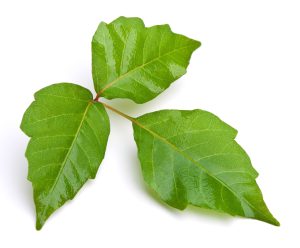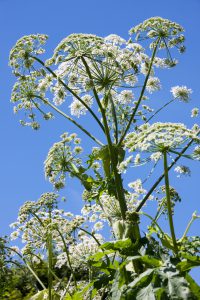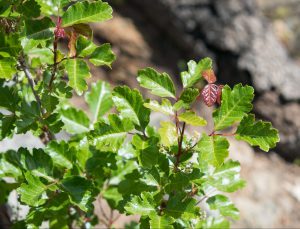Outdoor Workers and Poisonous Plant Exposures
Posted on byPoisonous Plants Are an Occupational Hazard

For many outdoor workers (and some who work indoors), contact with poisonous plants is a common work hazard. Workers at risk include construction workers, farmers, landscapers and arborists, gardeners, outdoor painters, roofers, and wildland firefighters. Common plants they may come in contact with include poison ivy, poison oak, poison sumac, devil’s club (devil’s walking stick), stinging nettle, jimson weed, milkweed, giant hogweed, ragweed, goldenrod, foxglove, agave, mistletoe, juniper, oleander, nightshade, and water hemlock. Some or all parts of these plants can be toxic to humans and animals.

Poisoning from plants is commonly reported to poison control centers. An estimated 85% of the population are prone to developing allergies to poison ivy, poison oak, poison sumac, and other poisonous plants (1). Poison ivy and related poisonous plants grow in the United States and throughout the world, transferring easily to people when plants touch the skin. Poison ivy and a related Toxicodendron species are considered a public health concern because they cause contact dermatitis, an inflammation of the skin caused by skin to plant contact (12).
The leaves, fruit, bark, or woody portion of plants and trees can touch the skin, resulting in mild to severe dermatitis. These are different types of dermatitis caused by exposure to plants:
- Mechanical dermatitis occurs when the skin is cut, punctured, or abraded by thorns, spines, and hairy appendages of plants that result in secondary infections.
- Irritant dermatitis can happen when an irritating chemical in the plant makes contact with the skin. This makes up about 80% of all contact dermatitis cases and is the most common occupational skin disorder. One example of an irritating chemical in plants is urushiol found in poison ivy.
- Phytophotodermatitis, the most common form of irritant dermatitis, occurs when a chemical in a plant (called a phototoxin) gets on the skin and then reacts with ultraviolet (UV) light from the sun. This reaction causes skin damage that begins as a patchy red rash with blisters.
- Allergic contact dermatitis requires prior exposure to a plant chemical, like urushiol, which sensitizes the immune system (5). As a result, antibodies form, leading to a more severe responses to the allergen with additional exposures.
Along with contact with the skin, workers can get exposed to plant toxins by breathing in poisonous plant matter (inhalation) or by eating the plant or getting the plant toxin into their mouth (ingestion) from hands, tools, equipment, or other surfaces containing the toxin.

What We Know About Poisonous Plant Exposure
As previously noted, the United States has a wide variety of poisonous plants. Poison ivy and its relatives, poison oak and poison sumac, are the most common cause of acute allergic contact dermatitis in the United States, estimated to affect 10–50 million Americans per year (1, 3).
The common phrase “leaves of three, let it be” has been passed down through generations, but in reality only applies to poison ivy because poison oak has three to five leaflets and poison sumac has 7 to 13 leaflets per stem. The classic allergenic dermatitis of these plants is caused by urushiol. Contrary to popular belief, for urushiol to come into contact with human skin, the plant must be damaged. Therefore, brushing up against the leaves is usually not enough to result in an allergic reaction (3, 8).
Other wild plants, such as wild parsnip and the invasive giant hogweed, contain phototoxins called furanocoumarins. When rubbed on the skin, furanocoumarins react with UV light to cause phytophotodermatitis (2, 11). If a person ingests furanocoumarins, it can cause liver damage, cellular mutations, and death (2, 4, 6, 7).
Further Research Needed

While we know a lot about poisonous plants and their risk to certain workers, many questions remain, such as the relationship between a worker’s age, health status, environmental conditions, and their susceptibility to poisonous plants. Future environmental and/or weather changes (higher heat, drought, rainfall, soil composition, increased carbon dioxide levels, etc.) may change the types and potency of both plant and animal allergens, toxins and/or poisons (12-13). If this results in the need for increased use of personal protective equipment (PPE) the risk for heat stress must be considered as a changing climate may also expose outdoor workers to higher environmental temperatures which may lead to an increased risk for metabolic heat stress (9).
Steps to Prevent or Reduce Exposure
Employers can
- Train workers on the poisonous plants that may be present in the area where they are working and what to do if exposed. Contact state and regional resources for accurate information on local poisonous plants.
- Provide suitable PPE to workers who are at risk of exposure, such as gloves, eye protection, or respirators (if needed). PPE should be cleaned per manufacturer instructions.
- Do not allow poisonous plant matter to be burned as the smoke may carry toxins into the air. When burning poisonous plants is unavoidable, a NIOSH-certified half-face piece particulate respirator rated N95, P95, or better is recommended.
- Respirators must be used in the context of a written comprehensive respiratory protection program (see OSHA Respiratory Protection standard 29 CFR 1910.134).
- Instruct workers to clean tools and equipment after use. Toxic oils and residues left on the equipment can affect others that touch and share the equipment.
- Provide soap and water to clean hands and skin.
- Educate workers to not handle, touch, or eat unknown plants, including fruits and nuts.
Workers can
- Be aware of the poisonous plants in the area where they are working based on training.
- Do not burn plants that may contain poison ivy, poison oak, or poison sumac.
- Wear long pants, boots, long sleeve shirts, gloves, and eye protection.
- Wash exposed clothing separately in hot water with detergent.
- Clean used tools with rubbing alcohol or soap and water. Wear disposable gloves during this process.
- Avoid touching their eyes or wiping plant fluids and sap on their clothing.
- Notify coworkers and supervisors if they have been exposed to hazardous plants.
- After exposure:
- immediately rinse skin with rubbing alcohol, poison plant wash, or degreasing soap (such as dishwashing soap) or detergent, and lots of water.
- Apply topical corticosteroids or antihistamine creams and sprays to provide relief and lessen the effects of allergic reactions to poison ivy, oak, etc.
- An oral antihistamine may help relieve itching. Follow the package directions.
- Oatmeal baths can provide temporary relief.
- See a doctor if the rash is severe, is located on the face or genitals, or has spread to other parts of the body or if there are signs of an inhalation exposure (difficulty breathing, swelling of throat and face, or a choking feeling). Call 9-1-1 if you experience a severe allergic reaction.
Stephanie Pendergrass, M.S., is a research chemist, biologist, AEMT, Structural and Wildland Fire Fighter, and Herpetologist in the NIOSH Division of Science Integration.
NIOSH Resources
- Limiting heat burden while wearing PPE
- Poisonous plants
- Skin exposures and effects
- Fast facts: Protecting yourself from poisonous plants
Additional Resources
- American Academy of Dermatology: Poison ivy, oak, and sumac
- National Institutes of Health (NIH): Poison Ivy, Oak, and Sumac: What is Know and What is New?
- NIH MedlinePlus: Poison ivy, oak, and sumac
- OSHA Factsheet: Working Outdoors in Warm Climates
- U.S. Food and Drug Administration: Outsmarting poison ivy and poisonous plants report
References
- American Skin Association [2020]. Poison ivy, sumac and oak, https://www.americanskin.org/resource/poisonivy.php.
- Dauncey EA, Larsson S [2018]. Plants that kill: a natural history of the world’s most poisonous plants. Princeton, NJ: Princeton University Press.
- Gladman AC [2006]. Toxicodendron dermatitis: poison ivy, oak, and sumac. Wilderness Environ Med 17(2):120–128, https://doi.org/10.1580/pr31-05.1.
- Ivie, GW [1978]. Toxicological significance of plant furanocoumarins. In: Keeler RF, Van Kampen, KR, James LF, eds. Effects of poisonous plants on livestock. Washington, DC: Academic Press, https://doi.org/10.1016/B978-0-12-403250-7.50052-2.
- Iyer K, Rengifo-Pardo M, Ehrlich A [2015]. Plant-associated dermatitis. J Dermatol Nurses Assoc 7(5):266–270, http://dx.doi.org/10.1097/JDN.0000000000000153.
- Kisielius V [2018]. Furanocoumarins: the defence of wild parsnip and giant hogweed. Department of Plant and Environmental Sciences, University of Copenhagen, Demark, https://natoxaq.ku.dk/toxin-of-the-week/furanocoumarins/.
- Lovell CR [1997]. Phytodermatitis. Clin Dermatol 15(4):607–613, https://doi.org/10.1016/s0738-081x(97)00062-x.
- National Park Service [2021]. Leaves of three, let it be, https://www.nps.gov/seki/planyourvisit/trail-safety.htm.
- NIOSH [2020]. Limiting heat burden while wearing PPE. Cincinnati, OH: U.S. Department of Health and Human Services, Centers for Disease Control and Prevention, National Institute for Occupational Safety and Health, https://www.cdc.gov/niosh/topics/heatstress/heat_burden.html.
- Washington State Department of Labor and Industries [2001]. Phyto Dermatitis: reactions in the skin caused by plants. Safety & Health Assessment & Research for Prevention, Report 63-8-2001, https://www.scribd.com/document/141943254/Phyto-Dermatitis.
- Ziska LH, Sicher RC, George K, and Mohan JE [2007]. Rising atmospheric carbon dioxide and potential impacts on the growth and toxicity of poison ivy (Toxicodendron radicans). Weed Science 55:288–292.
- Ziska LH, Epstein PR, and Schlesinger WH [2009]. Rising CO2, Climate Change, and Public Health: Exploring the links to plant biology. Environ Health Perspect 117: 155-158. Doi:10.1289/ehp.11501.
- Mohan JE, Ziska LH, Schlesinger WH, et al. [2006]. Biomass and toxicity responses of poison ivy (Toxicodendron radicans) to elevated atmospheric CO2. PNAS 102(24), www.pnas.org/cgi/doi/10.1073/pnas.0602392103
Posted on by

